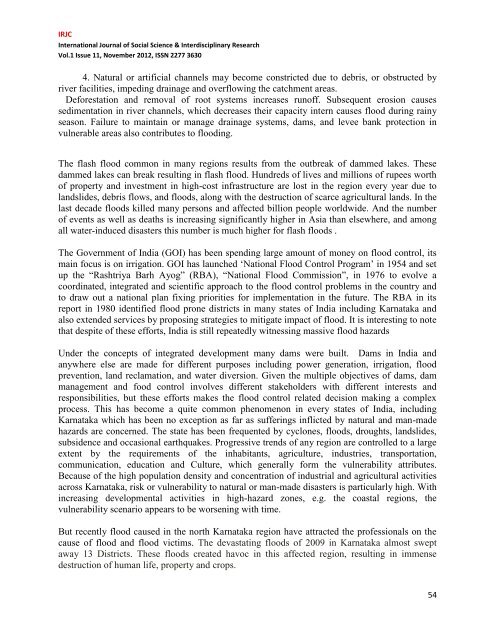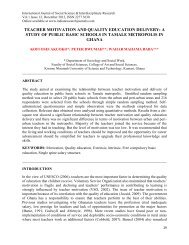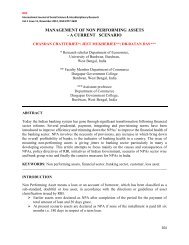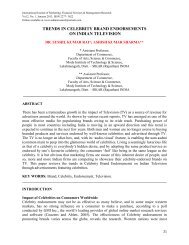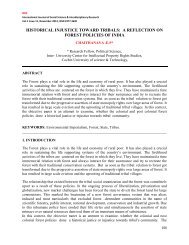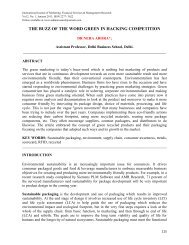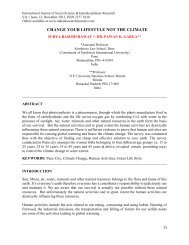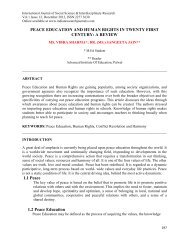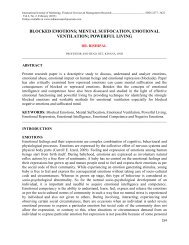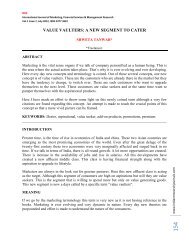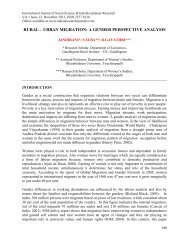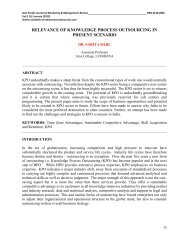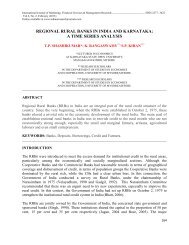application of remote sensing and gis for flood risk analysis: a case ...
application of remote sensing and gis for flood risk analysis: a case ...
application of remote sensing and gis for flood risk analysis: a case ...
Create successful ePaper yourself
Turn your PDF publications into a flip-book with our unique Google optimized e-Paper software.
IRJC<br />
International Journal <strong>of</strong> Social Science & Interdisciplinary Research<br />
Vol.1 Issue 11, November 2012, ISSN 2277 3630<br />
4. Natural or artificial channels may become constricted due to debris, or obstructed by<br />
river facilities, impeding drainage <strong>and</strong> overflowing the catchment areas.<br />
De<strong>for</strong>estation <strong>and</strong> removal <strong>of</strong> root systems increases run<strong>of</strong>f. Subsequent erosion causes<br />
sedimentation in river channels, which decreases their capacity intern causes <strong>flood</strong> during rainy<br />
season. Failure to maintain or manage drainage systems, dams, <strong>and</strong> levee bank protection in<br />
vulnerable areas also contributes to <strong>flood</strong>ing.<br />
The flash <strong>flood</strong> common in many regions results from the outbreak <strong>of</strong> dammed lakes. These<br />
dammed lakes can break resulting in flash <strong>flood</strong>. Hundreds <strong>of</strong> lives <strong>and</strong> millions <strong>of</strong> rupees worth<br />
<strong>of</strong> property <strong>and</strong> investment in high-cost infrastructure are lost in the region every year due to<br />
l<strong>and</strong>slides, debris flows, <strong>and</strong> <strong>flood</strong>s, along with the destruction <strong>of</strong> scarce agricultural l<strong>and</strong>s. In the<br />
last decade <strong>flood</strong>s killed many persons <strong>and</strong> affected billion people worldwide. And the number<br />
<strong>of</strong> events as well as deaths is increasing significantly higher in Asia than elsewhere, <strong>and</strong> among<br />
all water-induced disasters this number is much higher <strong>for</strong> flash <strong>flood</strong>s .<br />
The Government <strong>of</strong> India (GOI) has been spending large amount <strong>of</strong> money on <strong>flood</strong> control, its<br />
main focus is on irrigation. GOI has launched „National Flood Control Program‟ in 1954 <strong>and</strong> set<br />
up the “Rashtriya Barh Ayog” (RBA), “National Flood Commission”, in 1976 to evolve a<br />
coordinated, integrated <strong>and</strong> scientific approach to the <strong>flood</strong> control problems in the country <strong>and</strong><br />
to draw out a national plan fixing priorities <strong>for</strong> implementation in the future. The RBA in its<br />
report in 1980 identified <strong>flood</strong> prone districts in many states <strong>of</strong> India including Karnataka <strong>and</strong><br />
also extended services by proposing strategies to mitigate impact <strong>of</strong> <strong>flood</strong>. It is interesting to note<br />
that despite <strong>of</strong> these ef<strong>for</strong>ts, India is still repeatedly witnessing massive <strong>flood</strong> hazards<br />
Under the concepts <strong>of</strong> integrated development many dams were built. Dams in India <strong>and</strong><br />
anywhere else are made <strong>for</strong> different purposes including power generation, irrigation, <strong>flood</strong><br />
prevention, l<strong>and</strong> reclamation, <strong>and</strong> water diversion. Given the multiple objectives <strong>of</strong> dams, dam<br />
management <strong>and</strong> food control involves different stakeholders with different interests <strong>and</strong><br />
responsibilities, but these ef<strong>for</strong>ts makes the <strong>flood</strong> control related decision making a complex<br />
process. This has become a quite common phenomenon in every states <strong>of</strong> India, including<br />
Karnataka which has been no exception as far as sufferings inflicted by natural <strong>and</strong> man-made<br />
hazards are concerned. The state has been frequented by cyclones, <strong>flood</strong>s, droughts, l<strong>and</strong>slides,<br />
subsidence <strong>and</strong> occasional earthquakes. Progressive trends <strong>of</strong> any region are controlled to a large<br />
extent by the requirements <strong>of</strong> the inhabitants, agriculture, industries, transportation,<br />
communication, education <strong>and</strong> Culture, which generally <strong>for</strong>m the vulnerability attributes.<br />
Because <strong>of</strong> the high population density <strong>and</strong> concentration <strong>of</strong> industrial <strong>and</strong> agricultural activities<br />
across Karnataka, <strong>risk</strong> or vulnerability to natural or man-made disasters is particularly high. With<br />
increasing developmental activities in high-hazard zones, e.g. the coastal regions, the<br />
vulnerability scenario appears to be worsening with time.<br />
But recently <strong>flood</strong> caused in the north Karnataka region have attracted the pr<strong>of</strong>essionals on the<br />
cause <strong>of</strong> <strong>flood</strong> <strong>and</strong> <strong>flood</strong> victims. The devastating <strong>flood</strong>s <strong>of</strong> 2009 in Karnataka almost swept<br />
away 13 Districts. These <strong>flood</strong>s created havoc in this affected region, resulting in immense<br />
destruction <strong>of</strong> human life, property <strong>and</strong> crops.<br />
54


